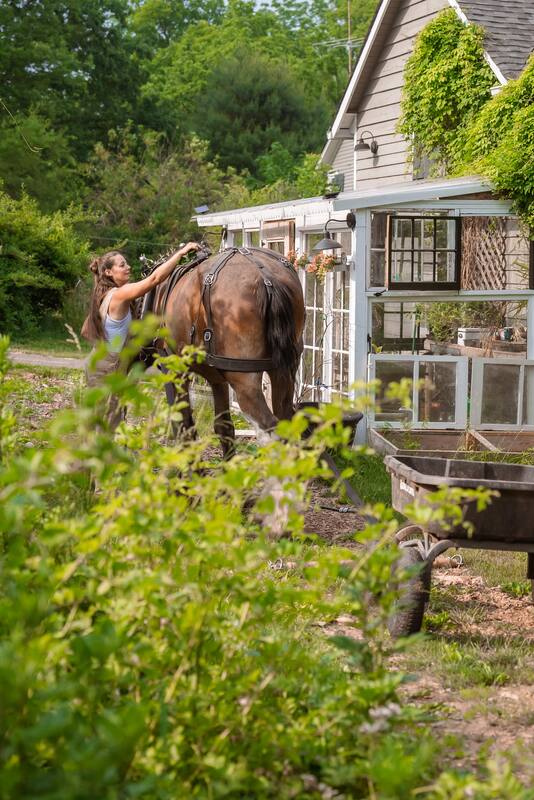|
That MidAtlantic humidity is high lately, making it feel like you’re wrapping yourself in a warm wet blanket when you step outside. Despite all the sauna vibes, I have a routine down for the animals to keep them as comfortable as possible. But before we dive into the list, I think it's worth mentioning that choosing the RIGHT animals for your homestead climate is so important for successfully navigating the seasons. Animal breeds vary greatly and some may be better suited to specific weather patterns and climates than others. Clydesdales, for example, are native to a wet region of the world--same as my climate here in New Jersey. Cold hardy duck breeds (like Cayuga) handle our winters better than those suited to warmer regions of the world. Before comfortably comes into play, I think there's a lot to be said for animal breed-homestead compatibility to begin with. Now, without further ado, here's just a quick bulleted list of the efforts I make to keep everyone comfortable in extreme heat situations here on the farm. HORSES
THE FLOCK
THE SHEEP
THE LIVESTOCK GUARDIAN DOGS
Time Stamps: Sacrifice Plot 0:13 / Winter Pasture Management 1:44 / Pasture Division and Rotation 2:37 / Winter Seeding 4:21 / Sacrifice Rehabilitation 6:11 / Dry Lot 6:33 / Foggage 7:02
A well managed pasture is an integrated plan—a series of efforts working together to create a grazing space that doesn’t detract from Mother Nature through unnecessary carbon loss, tillage, compaction, and erosion. Rather, several initiatives can be implemented to maintain the integrity of pasture spaces year-round without sacrificing quality of life and forage on the part of the animal. In this video I’m sharing the several different efforts I make to keep four draft horses, five sheep, and a flock of ducks and geese thriving on my six-acre farm without ruining my land. Through winter pasture management, implementing dry and sacrifice plots, winter seeding, foggage or standing hay growth, and proper pasture division and rotation in the warmer months, we can continue to keep our animals healthy and happy while remaining ecologically sound. Several relevant content sources to support this video
Our Holland Lop rabbits live the good life outdoors (with shelter) all spring, summer and fall. They graze on cover crops from our raised beds and other food growing spaces by spring. Come summer and fall, they graze the pastures and laws with the ducks and geese from the safety of their bun run. And in the winter, they retire inside the old duck and goose coop for extra protection from the cold. I'm sharing my set up, bedding, and thoughts on winter rabbit housing.
You can find the Bun Run video here Permaculture Duck and Goose Living video here You can also find the products I mentioned from Eaton Pet & Pasture here: Hemp Pet Bedding Nesting Pads If you follow mythology (or just watch Thor movies) then you know that Odin is the one-eye god of war and death. This name is most fitting for the horse who almost lost his life at a killpen... and who is also blind in one eye.
Odin is a Belgian draft aged about 15-18 years old based on his teeth. I bought him sight unseen just a week before he was to be shipped from a Texas killpen to slaughter at a processing plant in Mexico. Aside from his lack of sight in one eye, he has rotting hooves from the muck he's been living in, which was stuck up to his pasterns. He has lice, is very underweight, and is covered in callouses from his work harness. And despite all of this, he's a gentle soul. I've already bathed Odin, removed the muck, and have started salves and antibiotic ointments on his wounds and eye swelling. His lice has been treated and he'll have a follow up dose in two weeks. His hooves will take work and time, but we will get there. We’ll schedule dental too. Even though he's clearly had a rough go at life, and traveled 3,000 miles to finally find his forever home, he's in good spirits. He's curious, friendly, and happy to have loads of hay all to himself. As requested, I will share my quarantine protocol in a post next week. And I will also share my new intensive rotational grazing plan for keeping 4 draft horses on 6 acres without sacrificing land stewardship. Yup… tomorrow, one more horse arrives I just couldn't pass up. Thanks for all the luck sent our way to get this boy here safely. Welcome home, Odin. Thank you to everyone who recommended horse auctions, pens, sanctuaries and organizations for me to browse. If you’re looking, there are some great rescues out there. And loads more where this guy came from at Last Chance Direct Ship horses on Facebook. They provide a list of trans-continental transportation companies upon purchase. Note these are horses that need rest and recovery before work. Last Chance Direct Ship Horses Colby’s Crew Storeybrook Farm Gentle Giants Draft Rescue Connecticut Draft Horse Rescue Castleton Ranch Horse Rescue Horses Deserve a Second Chance Time stamps: On Finnegan: 0:15 // Meet the new horses: 1:00 // See the stable upgrade: 5:10
I have been putting off making this video because we recently endured a devastating loss on my permaculture farm; my partner and friend, Finnegan, passed away unexpectedly. While processing my grief, it was essential I find Dozer (my remaining Clydesdale mare) a stablemate because horses just don't do well alone. Very quickly, I found two beautiful horses we could offer a forever home to. Meet Sholto and Nevin, who are both already broke to ride and drive. In this video I'm sharing the new comers, talking about losing Finn, and showing the upgraded stable. A few amazing places to shop for a horse if you're open to adoption: Colby's Crew: https://colbyscrewrescue.org/ Horses Deserve a Second Chance: http://www.horsesdeserveasecondchance.com/ I rotationally graze my animals here at the homestead. Sheep ingest many parasites when they graze that affect horses, and the parasites are killed because they’re not ingested by the desired host. The horses do the same for the sheep. All the while, different nutrients are added to the soil through manure. Most often, the sheep follow the horses. You can see my rotation plan I put together when I was in school in the second slide. In these shots, however, the horses and sheep are lumped together, tandem grazing the backyard. My recent travels affected my pasture schedule so we’re using the backyard as a buffer while it all comes back in. Animals are introduced to a space when forage grasses reach 8-10” high, and forage legumes reach 10-12”. All animals are pulled from a space and it’s allowed to rest at 4”. Anything under that is considered over-grazed, and grows back much more slowly. As goslings mature into geese their wings become very heavy. Some drooping is normal as the bird develops the proper muscles to carry the weight of the wing. Other times, “slipped wing” or “angel wing” is to blame. This condition is caused by genetics, feeding too high of a protein content for too long or, in the case, the fact that my Large Dewlap Toulouse goose mated with my Sebastapol gander and produced a small bodied bird with large wings.
The condition is purely aesthetic but no doubt looks uncomfortable. Place the wings where they should rest and gently secure in place with vet wrap or a shirt. This does not hurt the bird… think of it like a wing bra for support. 🤣 Vet wrap, I find, is easiest. But an old t-shirt works in a pinch. You can secure a t-shirt with a hair tie until more vet wrap can be acquired. The bones of waterfowl grow at an astonishing rate. So this condition, if properly wrapped, can take just 4-5 days to correct. Change out the dressing as needed. Note this post is not a replacement for professional veterinary help. If you suspect a deformity or nutritional abnormalities in your bird, contact a veterinary professional for guidance and care. After a severe hoof rot infection, my vet helped me to eliminate the bacteria and heal my sheep in just over two weeks. We use trimming, Koppertox, SugarDine, cotton pads, vet wrap and duct tape. This dressing is changed every three days, more if the sheep can not be kept in a dry area. Inflammation was reduced and the wound puss was completely gone fast!
This post is not a replacement for professional veterinary care. It is meant for educational purposes only. Have your vet monitor the infection to ensure the sheep is healing. Discontinue use if irritation occurs. Answering some common Guinea Fowl questions today! If these are on your shopping list for spring, and you’re new to Guinea keeping, here’s some tips:
1. BREED // I have lavender guineas. I researched that they tend to be a quieter more relaxed breed. Compared to the white and helmeted breeds I’ve also had, I would say this is true. They’re not as high strung. 2. WANDERING // My guineas DO stay close to home, even when free ranging. I started them in a Guinea tractor my dad and I built. This allowed me to pass them through the entire property, keep them safe when young, and ensure all the ticky areas were grazed. After about three months in the tractor, they now get free range time. They know their home and don’t wander. 3. NOISE // Guinea fowl make noise, but no more so than our ducks and geese. What I didn’t expect was that they’d follow me everywhere all day, everyday. I have ten shadows now. They also tap on my windows when I go inside. #stalkers 🙄 4. FLOCK INTERMIXING // My guineas started in the tractor in the duck and goose field. They came to see the flock as non-threatening and are not territorial towards my other birds. 5. ROOSTING // The guineas are out 24/7 and roost in the trees above the ducks and geese by night. In inclement weather, I leave the barn door open and then go inside to roost if they prefer. 6. TICK REMOVAL // After a summer of Lymes for me and my dogs, I brought in guineas to remove ticks. Their presence has absolutely plummeted and we rarely find ticks now. WOULD I GET THEM AGAIN? In a heartbeat. Suspect worms in your flock? Sprinkle powdered cayenne pepper on top of your flock’s feed once per day, for three days. Can also be used weekly as a preventative. The cayenne powder burns away intestinal parasitic worms.
Old timers swear by this cheap and holistic approach to keeping their chickens healthy. Also safe for ducks, geese and guineas. I don’t have turkeys or other fowl so I haven’t tried it. Symptoms of infected birds may include: Low egg counts in spring, summer or other ideal laying conditions, weight loss, anemia, watery output and general poor health. Of course always consult a veterinarian as well if you have concerns. |
Angela is the farmer and content creator behind Axe & Root Homestead® LLC. This historic six-acre permaculture farm is home to two Clydesdale horses, ten honeybee hives, five sheep, two guardian dogs, barn cats and a flock of 40 geese and ducks. The farm produces maple syrup, fruit from a small orchard and loads of garden produce for consumption, preservation and donation to the local food pantry.
The Sustainable Homestead is available NOW!
Categories
All
|







